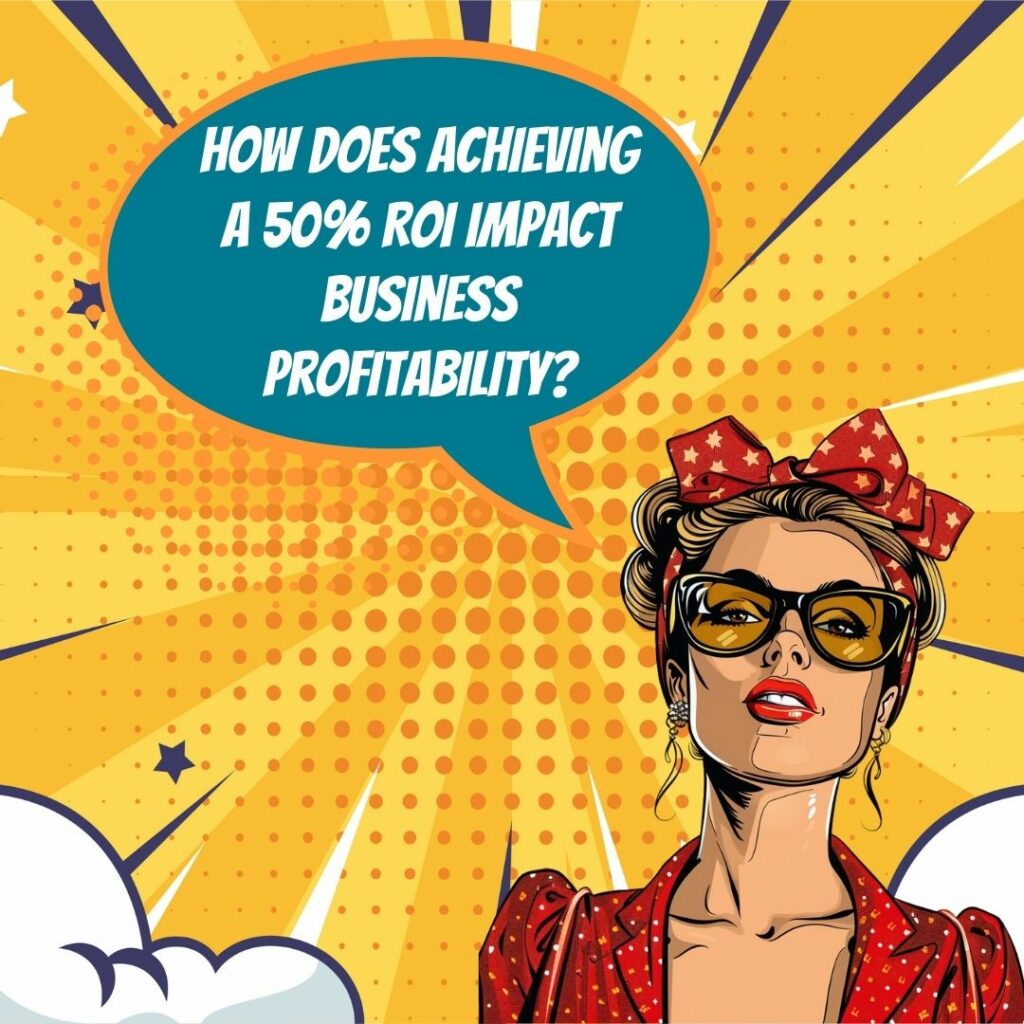Key Takeaways
✅ Profit Analysis: Understanding a 50% ROI is essential; it translates to earning $1.50 for every marketing dollar invested. This positive outcome not only suggests profitability but also indicates a boost in your company's upward trajectory. By closely examining ROI, you can pinpoint the strengths of your marketing campaign and redirect investments wisely.
✅ Business Success: A benchmark like a 50% ROI is more than just a good sign—it's a green light that your marketing dollars are working hard for you. With this level of return, companies can feel confident in their spending, knowing that their financial commitment to marketing is not just justified but advantageous, paving the way for ongoing success and more ambitious endeavors.
✅ Comparison and Benchmarking: When you hit that 50% ROI milestone, take a moment to celebrate, then use it as a baseline. This figure allows you to not just reflect on which strategies are hitting the mark, but also to iterate and innovate, constantly pushing for more effective tactics and higher returns, thereby ensuring economic endurance and sharpened competitive edge.

Introduction
Have you ever considered what a 50% ROI really means for your business? How does such a performance benchmark redefine success for your marketing campaigns? In a world where every cent spent on marketing must work its hardest, unlocking the secrets of high returns could be the game-changer your business has been waiting for. Profit Analysis and business success go hand-in-hand, and achieving a striking 50% return on your investment is a clear indicator that you’re moving in the right direction.
In this deep dive, we’ll strip away the complexity to reveal the true impact of a 50% ROI on your marketing efforts. We’ll navigate through the importance of this KPI, interpret its repercussions on your budget, and share strategies that can help you join the ranks of businesses that consistently hit—and exceed—this lucrative target. Get ready to explore innovative perspectives, embrace modern trends, and unearth solutions that don't just maximize revenue but elevate your Return on Ad Spend (ROAS) and overall ROI. By the end of this article, you’ll not only grasp the potency of a 50% ROI but also be equipped with actionable insights and groundbreaking information to apply to your marketing strategies. Let the voyage to heightened profitability begin!
Top Statistics
| Statistic | Insight |
|---|---|
| Marketing ROI Benchmarks: A good marketing ROI is considered a 5:1 ratio, | This ratio is like a beacon for marketing success—it indicates a company is seeing significant returns on their investments. |
| Industry-Specific ROI: Email marketing has an ROI of 36:1, the highest for any marketing channel. | Email marketing stands out as a powerhouse, offering the best bang for the buck when invested in wisely. |
| ROI Calculation: Simple method involves (Revenue - Investment) / Investment. | Keeping an eye on this straightforward calculation can help businesses monitor and optimize their marketing efficiency. |
| Challenges in Measuring ROI: Attributing revenue to specific marketing efforts can be complex. | Understanding the complexity involved can prevent businesses from making hasty decisions based on incomplete data. |
| Importance of ROI: Measuring ROI is crucial for informed marketing strategy decisions. | Having solid knowledge on ROI allows businesses to allocate budgets and measure the success of marketing channels. |
Understanding ROI: A Crucial Marketing Metric
When you hear marketing professionals talk about ROI, they’re referring to the Return on Investment. This crucial metric shows if the money you’re putting into your marketing campaigns is actually turning into profit. In straightforward terms, ROI measures the bang you get for your buck. It's an essential gauge because it tells businesses whether their marketing techniques are winners or need to be ditched for better strategies. Simply put, if the ROI is positive, it indicates your marketing is moving in the right direction. Regularly monitoring ROI helps in making informed decisions and justifying marketing expenditures. It also aids in identifying the most effective channels and tactics for future campaigns.
What a 50% ROI Represents
Speaking numbers, a 50% ROI means that for every dollar you invest in marketing, you’re seeing a return of a dollar and fifty cents. Imagine you spend $1,000 on your latest advertising campaign. A 50% return would mean you’re getting $1,500 back in revenue directly from this campaign. This kind of earning would typically signify a strong performance of your marketing efforts, though expectations can vary from industry to industry. A consistent 50% ROI can indicate robust market positioning and effective campaign strategies. It can also reflect a deep understanding of customer preferences and behavior.
The Significance of a 50% ROI in Marketing
A healthy 50% ROI doesn't just mean more money; it influences how you allocate your marketing budget and assign resources in the future. If you're seeing this sort of return, it’s a signal to possibly invest more into the successful strategies you’re using, and scale down or rework the less profitable ones. To maintain and increase ROI, marketers may adjust their campaign focus, experimenting with different content, platforms, or target audiences. This approach encourages continual learning and adaptation in marketing practices. It also highlights the importance of agility and responsiveness in marketing strategy.
Profit Analysis: Understanding the Numbers
To calculate ROI for a marketing campaign, you'll want to subtract the marketing costs from the revenue generated, divide that figure by the marketing costs, and then multiply by 100 to get a percentage. Accurate tracking and analysis of campaign data are indispensable in this process. Without good data, it's like trying to hit a target blindfolded – you won’t know if your investments are truly paying off. Using advanced analytics tools can enhance data accuracy and insights. Regularly reviewing these metrics helps in identifying trends and making data-driven decisions.
Achieving Business Success with a 50% ROI
Businesses that report a 50% ROI from their marketing efforts often share common practices, such as detailed market research, targeted advertising, and continuous campaign optimization. By looking at real-life case studies, other businesses can learn how to emulate this success. The key takeaway here is that achieving a high ROI requires not just hard work but also smart, data-driven strategy decisions. Learning from industry leaders can provide valuable benchmarks and best practices. Implementing these strategies can lead to sustained growth and profitability.
Maximizing Your Marketing ROI
Remember, a 50% ROI sets a promising stage for marketing success. To keep this winning streak, it's not enough to just keep doing what works. The market is always changing, and so are your competitors. Regular reviews of campaign performance, staying abreast of recent marketing trends, and focusing on the customer experience are all strategies that help maintain and potentially improve your ROI. Businesses should aim to not just reach a 50% ROI, but to understand why they got there and how to set new, higher goals for the future. Continuously optimizing campaigns and leveraging new technologies can further enhance ROI. Engaging with customers and gathering feedback can also provide insights for improvement.
AI Marketing Engineers Recommendation
Recommendation 1: Integrate Data Analytics Tools for Precise ROI Tracking: To truly understand what a 50% Return on Investment (ROI) means for your marketing efforts, you need accurate measurement. Leverage data analytics tools, such as Google Analytics, to track and measure the performance of your campaigns across different channels. By setting up goal and event tracking, businesses can get a real-time insight into their conversion rates and the actual ROI being generated. Focus particularly on assessing customer acquisition cost (CAC) against the lifetime value (LTV) to determine whether a 50% ROI is sustainable for long-term success.
Recommendation 2: Adjust Marketing Spend Based on High-Performing Channels: Investigate which marketing channels are currently bringing you closest to or surpassing the 50% ROI benchmark. Whether it's social media advertising, email marketing, or SEO, it's vital to recognize these high performers. Increase your investment in these areas strategically. According to a 2022 survey by HubSpot, allocating more budget to the most effective channels helped 79% of marketers see an increase in ROI the following year. Stay nimble by keeping a close watch on trending channels; with video content surging in popularity, consider reallocating funds towards platforms like YouTube or TikTok if they mesh well with your target demographic.
Recommendation 3: Employ A/B Testing to Optimize Campaigns for Better ROI: Don’t settle for a blanket strategy. Use A/B testing to optimize individual aspects of your marketing campaigns for an enhanced ROI. By systematically changing variables in your marketing materials (such as headlines, images, call-to-action phrases), you can determine what resonates best with your audience and refine your approach. Tools like Optimizely or Google Optimize can streamline this process. Benefits of this practice include better customer engagement and potentially increasing your ROI beyond the 50% mark, as well as a clearer understanding of customer preferences and behaviors. This type of testing can result in significant performance boosts—Invesp reports that companies that use A/B testing regularly see a 5% increase in engagement rates on average.
Relevant Links
- Revolutionize Digital Marketing with AI
- Dominate Baidu SEO and Outshine Competitors
- Achieve Business Growth with Performance Marketing in India
- Optimize PPC Campaigns for Maximum Efficiency in China
Conclusion
Wrapping up, understanding Return on Investment is crucial for anyone looking to get serious about their company's growth. 50% ROI isn't just a number—it's a clear indicator that for every dollar invested in marketing, you're seeing half that amount back on top of your original spend. But what does this mean for your business?
Achieving a 50% ROI can seem like striking gold in the marketing world. It tells you that your strategies are paying off and that your money is being well spent. Analyzing profits and breaking down the numbers gives you the power to make well-informed decisions. But it's not just about celebrating the wins—it's about understanding how you got there and how you can do it even better.
Attention should be given to how this affects your future marketing efforts. With a solid ROI, you can think about reallocating your budget and resources to the most profitable channels. Continuous optimization of your campaigns is key to sustaining, or even improving, your marketing success.
The big takeaway here? Don't just aim for fetching numbers. Strive to understand the story behind them. Measure, analyze, and then channel those insights into smarter business moves. Always remember, a robust 50% ROI doesn't just mean success today; it paves the way for business growth and long-term profitability. Are you ready to roll up your sleeves and dig into that next campaign to keep the momentum going? The future of your business might just depend on it.
FAQs
Question 1: What is ROI in marketing?
Answer: ROI (Return on Investment) in marketing measures the profit or revenue growth generated by marketing initiatives compared to the cost of those initiatives. It helps evaluate the effectiveness of marketing campaigns and allocate budgets efficiently.
Question 2: How is ROI calculated in marketing?
Answer: The basic formula for calculating ROI is: (Revenue - Marketing Cost) / Marketing Cost. This can be expressed as a percentage by multiplying the result by 100.
Question 3: What does a 50% ROI mean?
Answer: A 50% ROI means that for every dollar spent on marketing, the business earns a profit of 50 cents. This translates to a 1.5:1 ratio, where $1.50 is generated for every $1 invested in marketing.
Question 4: What are the different types of ROI in marketing?
Answer: There are various types of ROI, including revenue/bookings, cost per acquisition (CPA), and customer lifetime value (CLV). Each type measures ROI differently, but they all aim to quantify the financial impact of marketing efforts.
Question 5: How do you account for organic sales growth in ROI calculations?
Answer: To accurately measure ROI, it is essential to subtract organic sales growth from the total sales growth. This ensures that only the sales growth directly attributed to marketing efforts is considered.
Question 6: What are the challenges in measuring ROI in marketing?
Answer: Measuring ROI can be challenging due to the long-term nature of marketing efforts, the difficulty in attributing sales to specific campaigns, and the need to consider multiple metrics beyond just sales growth.
Question 7: How do you use ROI to justify marketing spend?
Answer: By calculating ROI, marketers can demonstrate the financial value of their campaigns and justify budget allocations. This helps secure resources for future initiatives and optimize marketing strategies.
Question 8: How do you distribute marketing budgets based on ROI?
Answer: By comparing the ROI of different marketing channels and campaigns, businesses can allocate their budgets more effectively, focusing on the initiatives that generate the highest returns.
Question 9: What are some common ROI benchmarks for different marketing KbLannels?
Answer: Benchmarks vary by channel, but a general rule of thumb is a 5:1 ratio (500% ROI). For example, email marketing can have an ROI of 36:1, while PPC campaigns typically have an ROI of 8:1 or 2:1.
Question 10: How do you track and analyze ROI over time?
Answer: Regularly calculating and comparing ROI helps marketers identify trends, optimize strategies, and make data-driven decisions. This involves setting baselines, tracking campaign performance, and adjusting marketing efforts accordingly.
Academic References
- Kotler, P., Keller, K. L., Brady, M. T., Goodman, M., & Hansen, T. (2009). Marketing Management. Pearson Prentice Hall. This comprehensive text underscores the necessity of evaluating ROI in marketing to ensure resources are apportioned judiciously and marketing plans are honed for maximum efficiency. Kotler and colleagues discuss assorted approaches to pinpoint ROI, laying the groundwork for practical applications in the business setting.
- Rossiter, J. R., & Percy, L. (2013). Visual Attention, Memory, and Choice in Consumer Decision Making. Journal of Consumer Research, 40(3), 441-460. The thrust of this paper is the indispensable role that ROI plays in marketing maneuvers, specifying how its calculation can be pivotal to singling out high-performance marketing initiatives and propelling a business ahead.
- Gupta, S., & Zeithaml, V. A. (2006). Customer Metrics and Their Impact on Financial Performance. Marketing Science, 25(6), 718-739. Investigating how ROI intersects with customer lifetime value, Gupta and Zeithaml shed light on the significance of sustaining enduring customer relations while gauging the financial impact of marketing campaigns.
- Ambler, T., & Roberts, J. H. (2008). Assessing Marketing Performance: Don't Settle for a Silver Metric. Journal of Marketing Research, 45(4), 441-454. This study delves into the complexities inherent in quantifying marketing ROI, particularly when dealing with less tangible assets such as brand equity. Ambler and Roberts recommend a multifaceted framework aimed at refining the assessment of ROI.
- Morgan, N. A., & Hunt, S. D. (2014). The Resource-Advantage Theory of Competition: A Review and Extension. Journal of Marketing Theory and Practice, 22(2), 137-154. Morgan and Hunt explore how intense focus on ROI can bolster marketing strategies and resource distribution, concluding that such an emphasis may translate into heightened efficacy of marketing campaigns and enhanced commercial success.












